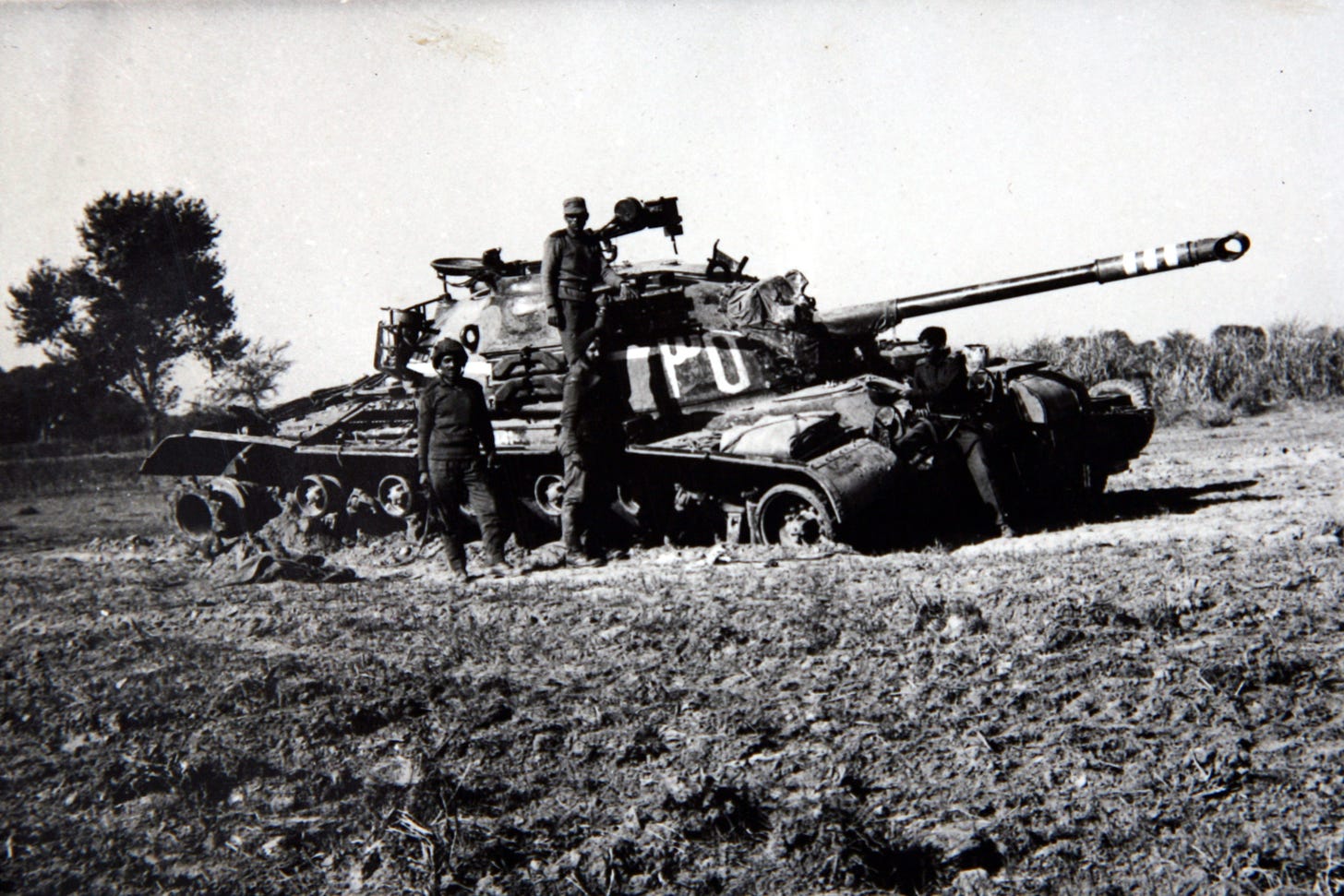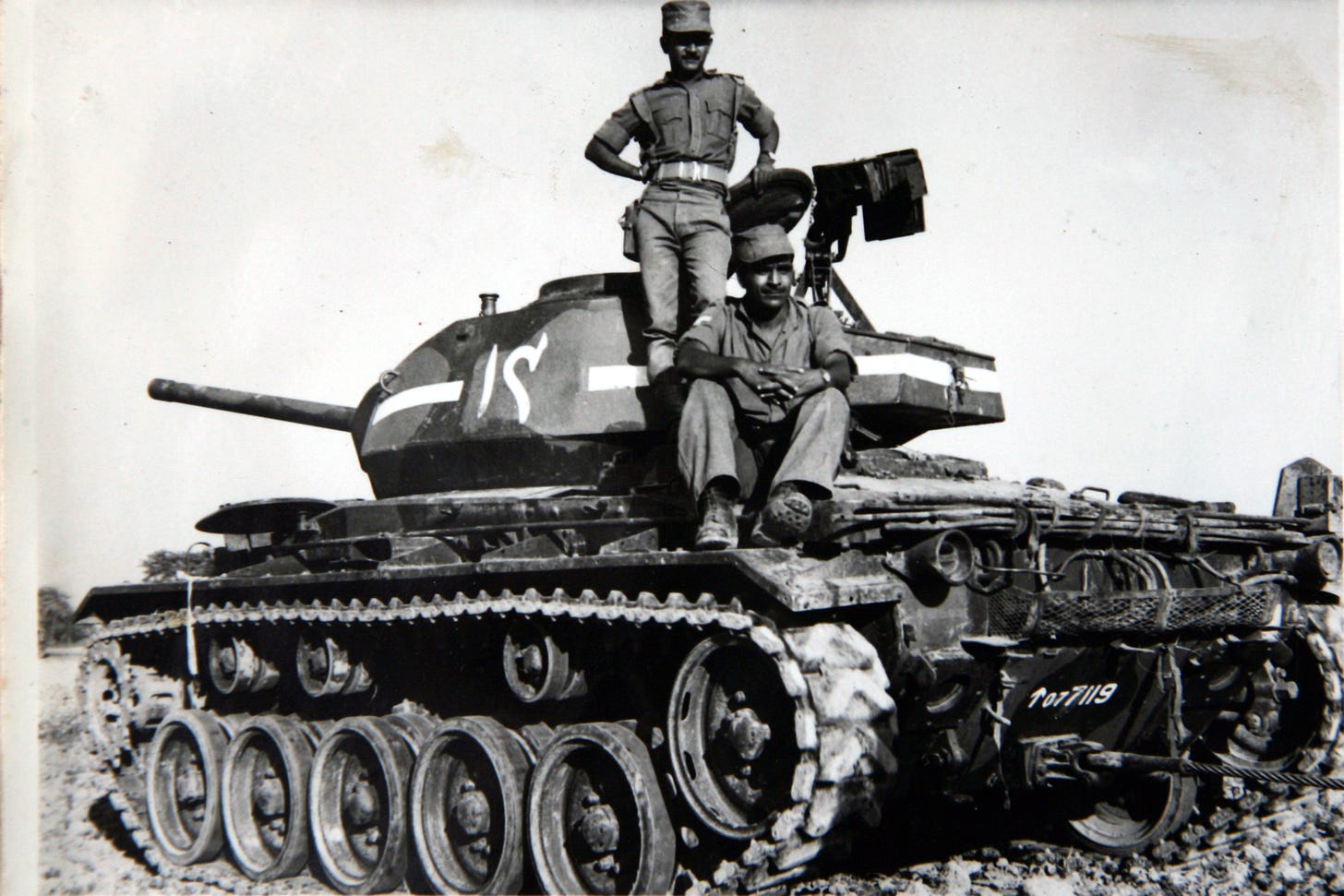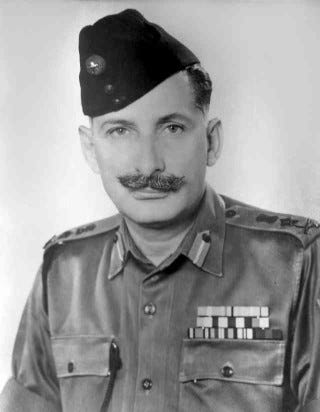The armored actions of the 1965 and 1971 India-Pakistan Wars have been overshadowed by more spectacular battles in the Middle East. However, those interested in studying and gaming armored warfare can learn much from the armored battles fought by India and Pakistan in their 1965 and 1971 Wars, specifically the battles of Chawinda, Kehm Karan, and the Shakargarh Bulge. These battles are fine illustrations of how both recklessness and over-caution can lead to defeat.
Two Battles in 1965
The 1965 war was launched by Pakistani president Ayub Kahn, who hoped to seize control of the disputed Kashmir region as well as the Rann of Kutch to the south. Pakistan began the war in April with a paramilitary attack in the Rann of Kutch. With Indian attention drawn to the south, in August 60,000 Pakistani regular army and paramilitary troops invaded Kashmir. Indian regular army forces easily handled the wildly dispersed columns and had repulsed the Pakistanis by the end of the month. In September Kahn decided to begin the third phase of the operation, and sent Pakistani regular army forces into Kashmir.
It was at this point that the Indian government launched a major counterattack, not in Kashmir, but to the south, a two pronged effort aimed at Sialkot and a further fifty miles to the south against Lahore. Taking Sialkot would secure the Indian flank in Kashmir, while taking Lahore, a major city and transportation hub 15 miles across the border, would eliminate a staging area for the Pakistani Army. The ensuing fighting led to two large scale and interesting armor battles, the largest since the Second World War.
The Battle of Chawinda
The first of these was fought at Chawinda. The battle of Chawinda pitted an Indian armored division, outfitted with British Centurion tanks, against its Pakistani counterpart using American Pattons. The battle also pitted Indian over-caution against aggressive Pakistani defense. The Indian attack was taken up by Indian I Corps (6, 14 and 26 Infantry Divisions, 1 Armored Division), commanded by General P.O. Dunn. Under Dunn’s plan Indian 6 and 26 Infantry Divisions would cross the Ravi River and cleave open a hole in Pakistani lines, through which Indian 1 Armoured Division would advance on Chawinda. Opposing Indian I Corps was Pakistan 8 Infantry Division (four brigades) and 6 Armoured Division (four armored regiments).
The Indian offensive began on the night of 7 September. By the morning both Indian 6 and 26 Infantry Divisions were across the Ravi River in strength. Indian 6 Division pushed south, while 26 Infantry Division drove north and took up blocking positions opposite Sialkot. With the flanks secure Indian 1 Armoured Division, commanded by General R.J. Singh, advanced through the gap. The division attacked on a two brigade front, with the 43 Lorried Infantry Brigade on the right (north), and 1 Armoured Brigade on the left (south).
Pakistani 24 Infantry Brigade was to the southwest of the Indian advance, at Jasser. The brigade commander ordered his armored regiment, 25 Cavalry, to advance northeast and investigate the Indian breakthrough. The regiment made contact with Indian 1 Armoured Brigade after dawn on 8 September. Despite being heavily outnumbered by the Indians the regimental commander chose to attack. Pakistani 25 Cavalry advanced with its three squadrons forward, line abreast, and engaged the Indians head on, exchanging fire with Indian tanks for several hours. The Indian commander sent a regiment to outflank Pakistani 25 Cavalry, but this was spotted by the Pakistanis and brought under fire. With his advance halted by a mere cavalry regiment of three squadrons, the Indian brigade commander pulled back.
Believing that they were facing a much larger Pakistani force, General Singh waited for reinforcements, in this case two infantry brigades, before resuming the attack two days later on the 11th. This was a costly delay as by this time, the Pakistanis had reinforced the Chawinda area with 6 Armoured Division.
The Indian plan was to once again break through Pakistani lines, hold the gap open, and drive on the village of Phillora, a few miles northeast of Chawinda, aking it as a preliminary move for an attack on Chawinda proper. The village was defended by Pakistani 11 Cavalry Regiment. Once again Indian 43 Lorried Infantry advanced on the right, with 1 Armoured Brigade on the left. Indian 43 Lorried Infantry Brigade took its objective, the village of Rurki Kalan without incident, securing 1 Armoured Brigade’s flank. The brigade advanced against Phillora on a two regiment front, sending one around each flank. The pincer movement succeeded, with Pakistani 11 Cavalry suffering heavy casualties inside Phillora. The Pakistani divisional commander launched a counterattack from the northwest, sending two armoured regiments against the Indian right, but these were blocked by dug in Indian infantry supported by an armoured squadron.
With the flank now secure Indian troops were in Phillora by nightfall. While Phillora was in Indian hands and the stage set for an attack on Chawinda, Singh's hesitance had allowed the Pakistanis to amass a powerful force and prepare for the next Indian attack. The Pakistanis reorganized their defenses around Chawinda, deploying nine regiments in an arc around the town. On 14 September Indian 1Armoured Division attacked, with 43 Lorried Infantry Brigade attacking the town proper and1 Armoured Brigade attacking to the north with the goal of getting behind Chawinda. General Singh moved Indian 69 Mountain Brigade (which had arrived as reinforcements) forward to secure the southern flank. Several sharp battles erupted in the small villages in front of Chawinda, Pakistani forces entrenched here held up the Indian attack, as did effective Pakistani artillery, which constantly broke up Indian forces as they concentrated for an attack. By the end of the day the Indians had made scant progress and called off the attack on Chawinda. They attacked again the next day, with two regiments advancing against Pakistani lines, but these were broken up by heavy artillery fire. By then three different artillery brigades were massed around Chawinda. While some Indian armored units took their initial objectives, they were eventually driven back by fierce Pakistani counterattacks.
Well employed Pakistani artillery was partially responsible for holding Chawinda, but the main culprit in the Indian failure was General Singh, whose over-caution allowed the Pakistani's time to organize their defenses. After the debacle before Chawinda, General Dunn pulled 1 Armoured Division back and gave the operation over to 6 Infantry Division. Their attack, launched on 19 September, also failed to take Chawinda. The town remained in Pakistani hands at the time of the cease fire on 23 September.
The Battle of Kehm Karan
The second great armored action of the 1965 war was fought by Indian XI Corps south of Amritsar in central Punjab. The terrain is flat, fertile, and crisscrossed by roads, railroads and canals. There is no natural border. Pakistani defenses were concentrated along the Ichhogil Canal, specially constructed for that purpose. Under command of General J.S. Dhillon, Indian XI Corps was to cross the border, occupy the east bank of the canal, and establish several bridgeheads on the west side. To accomplish this Dhillon had under his command 4 Mountain Division as well as 7 and 15 Infantry Divisions.
Indian XI Corps crossed the border on 5 September and advanced on a three division front. The Indians saw hard fighting but established a presence on the east bank as early as the 6th. However Pakistani resistance was dogged and the Indians were unable to clear the entire east bank until the 11th. Indian XI Corps’ southern thrust, conducted by 4 Mountain Division, was subjected to a fierce Pakistani armored counterattack. Its mission was defensive, to simply advance to the canal and destroy several bridges in the hopes of preventing a Pakistani counterattack from this area. While units of 4 Mountain Division were able to advance to the canal, they were unable to destroy the bridges before Pakistani artillery fire and air attacks drove them off the bank, logistical difficulties prevented engineers from moving forward to set demolition charges.
The Indian’s failure to carry out a routine military task left the door open for the counterattack General Dhillon had feared. The Pakistanis had ample forces in the area for a counterattack These were 1 Armoured and 11 Infantry Division, under the overall direction of General Javed Nasir. Pakistani 1 Armoured Division was divided into three brigades and had five armoured regiments, four of M-47/48 Pattons and one of M-24 Chafees. GHQ had decreed the main objective should be Amritsar, 20 miles away.
The first phase of the Pakistani counterattack, ordered by GHQ and carried out by General Nasir, began on 7 September, at Ballanwala, a crossing held by elements of Indian 7 Brigade. The bridge here was still up. Pakistani armor forces easily pushed aside the pair of infantry battalions at Ballanwala and threatened to get behind the entire brigade, whose commander sensibly fell back. With a breakthrough achieved it was now the Pakistanis who halted, at Kehm Karan a few miles east, in this case to construct a second bridge across the canal, as the original had been damaged.
On 8 September General Ahmed Kahn, GOC 1 Armoured Division, ordered Pakistani 5 Armoured Brigade to advance northeast on a two regiment front and seize the Volthoa train station and the village of Asal Uttar. The result was a rout. Two Pakistani armored regiments advanced on the positions of Indian 62 Mountain Brigade. Pakistani armor blasted Indian positions and then infiltrated through their lines in small groups. Three of the six Indian battalions on scene broke and ran while the remaining Indian troops were isolated into small pockets. Now General Kahn had a decision to make. Pull back the two armored regiments, who were dangerously exposed to counterattack, or consolidate his gains? He elected to withdrawal. Given the exposed position of the regiments this decision is not indefensible. Still, consolidating his hold on Volthoa and Asal Uttar would have set the stage for further exploitation and enabled the Pakistanis to maintain momentum, this was a mistake.
The Indians used the respite to good advantage. Reinforcements arrived in the form of Indian 2 Independent Armoured Brigade. The Indian 62 Mountain Brigade's commander reformed his troops and deployed them in a horseshoe around the Pakistani salient. Indian tanks were dug in and camouflaged, supported by minefields and anti-tank ditches, as well as teams of recoilless rifle armed jeeps. Waterways guarded both flanks. There was some skirmishing on the 9th, as Pakistani forces attacked Indian positions near the canal at Bhikhiwind and Patti, but this effort was turned back by the fanatical resistance mounted by the Indian Rajputana Rifles, which fought on even as Pakistani tanks overran their positions.
The Pakistani's launched a division scale attack on 10 September. Pakistani 1 Armoured Division advanced on a two brigade front, with 4 and 5 Armoured Brigades in the lead and 3 Armoured Brigade bringing up the rear. Pakistani 4 Armoured Brigade's attack was led by 4 Cavalry Regiment which was caught in a crossfire of Indian guns and tanks and all but destroyed. What was left of the regiment withdrew in the afternoon, leaving forty smoldering Pattons behind. On the left, Pakistani 5 Armored Brigade advanced northeast with the goal of getting behind Indian 62 Mountain Brigade. However the Indians had breached the canal and flooded the ground before the Pakistani advance. The Pakistanis became bogged down in the water and mud and easy targets for the RCL Jeeps, which picked off the Pakistani Patton Tanks one by one. What was left of Pakistani 4 and 5 Armoured Brigades withdrew, leaving more than 90 tanks burning on the battlefield. General Kahn never committed Pakistani 3 Armoured Brigade to the fight. The Indians attacked the next day, but this effort was easily turned back. There was intermittent skirmishing for the next week until the ceasefire.
1971: The Battle of Shakargarh
In at least one great armored battle, Indian commanders showed enough élan and dash to fight on their own terms. When East Pakistan tried to succeed from Pakistan in 1971, West Pakistan launched a brutal campaign of repression resulting in hundreds of thousands of refugees fleeing to India. Indian Prime Minister Indira Gandhi resolved to come to East Pakistan's aid. In November of that year the Indian army crossed into East Pakistan beginning the 12 day liberation war.
In conjunction with the campaign in the east, the Indian Chief of Staff, General Sam Manekshaw, was determined to engage Pakistani forces in the west with the goal of eliminating Pakistani operational threats on the border. One of Manekshaw's objectives was to pinch off the Shakargarh Bulge, a spit of land jutting into India and threatening communications along the Grand Trunk Road to Kashmir. the salient was occupied by Pakistani I Corps, composed of one infantry division, one infantry brigade and an Independent armored brigade. The job fell to Indian I Corps, a force of three infantry divisions and two armored brigades. On 8 December I Corps, led by Indian 54 Infantry Division, crossed into the bulge and drove east to the Basantar River, sweeping aside Pakistani forces before them. The Indians established several bridgeheads on the west bank of the Basantar and moved reinforcements across.
Indian 47 and 91 Brigade's pushed west, clearing several small villages which had been occupied by Pakistani forces. One regiment, 17 Puna Horse, pushed Pakistani forces out of the Lallal Forest Reserve to the south. The Indians consolidated their gains. One squadron of the Poona Horse occupied the Forest Reserve with another taking up positions to the north. A third squadron was held in reserve. Elements of Indian 47 Infantry Brigade moved forward to support. The Indians also deployed teams of tanks and artillery pieces in the several small villages just west of the reserve. Because Indian forces kept moving and maintained pressure they forced the Pakistanis to attack on terms favorable to the Indians.
By 16 December the Indians were in a position to move against the town of Zafarwahl, which would set the stage for a drive on the city of Shakargarh. The Pakistanis decided to counterattack and ordered Pakistani 8 Independent Armoured Brigade to advance. The brigade had three regiments outfitted with M-48 Patton Tanks, a mechanized infantry battalion, and an artillery regiment.
The Pakistanis attacked on a two regiment front in the north, 13 Lancers (three squadrons in all) drove on Indian forces in the villages of Sikandupur and Ghazipur west of the reserve. Advancing without artillery support, A Squadron of 13 Lancers took heavy fire from Indian forces, losing six tanks before pulling back. The regimental commander then sent B and C Squadrons dashing forward for the village of Jarpal, just south and east of the reserve. These squadrons took heavy fire from Indian forces there and the nearby villages losing 20 tanks before withdrawing. The two Indian platoons in Jarpal pursued and broke up 13 Lancers as it was reforming and destroyed several more Pakistani tanks. At the same time Pakistani 31 Cavalry attacked the southeast corner of the Indian position. They advanced with one squadron forward and two back providing support fire and an accompanying artillery barrage. Even so, advancing in the open, the Pakistanis were easy targets for the Indians, who took out 14 tanks in short order. The Pakistanis were not fool enough to send the other two squadrons forward and called off the rest of the attack.
War Gaming It
When gaming the Indo-Pak wars, one must keep in mind the strategic dilemma each country faces. Pakistan lacks both strategic depth and the ability to strike deep into India. While India has the ability to defeat the Pakistani army and occupy large swaths of territory, it has no desire to do so. Despite India's advantages in sheer numbers the conquest of Pakistan presents several operational challenges. The first of these is Geography. Several rivers crisscross central Pakistan, hampering any advance. Also, Islamabad is well protected by mountains to the east and north.
These realities are well reflected in Showdown, a modern simulation of a war between India and Pakistan published by Decision Games. Showdown is conducted on the operational level, with most counters representing divisions. Part of the Decision Games Folio series, Showdown's system revolves around the allocation of artillery and air support to resolve combats. Decision Games has also published Indo-Pakistani Wars, an operational level game which allows players to simulate the 1965 and 1971 wars. With a map showing the western border and another detailing what is now Bangladesh, players are able to refight the 1971 War in its entirety. A third scenario simulates a future war between the two nations. Originally published in 1995, Indo-Pakistani Wars provides gamers with an opportunity to make modernizing updates that would account for India's closer relationship with the United States, and its acquisition of Russian made T-90 tanks. Modern Conflict Studies has, as part of its Millennium Wars series, an operational level game focusing solely on Kashmir.
On a tactical level, Indian commanders were hampered by crippling hesitation. Where bold armored advancing might win a battle, Indian generals instead paused and consolidated. Pakistani officers often suffered from over caution and recklessness in the same battle. At Kehm Karan General Kahn's decision to pull back allowed the Indians to regroup, while his attack into the teeth of their defenses was a reckless maneuver doomed from the start.
Those interested in taking a look at tactical scenarios would do well to check out Blow by Blow The Battle of Attal Ussar India Pakistan War 1965, their name for the above mentioned Battle of Khem Karan. Blow by Blow has a complete map of the battle area and counters representing and rating the differing performances of Pakistani M-48s and M-24s against Indian Centurions. With a little imagination this system could be adapted to depict the armored slogs at Chawinda or the Pakistani attack at Shakargarh Bulge.






